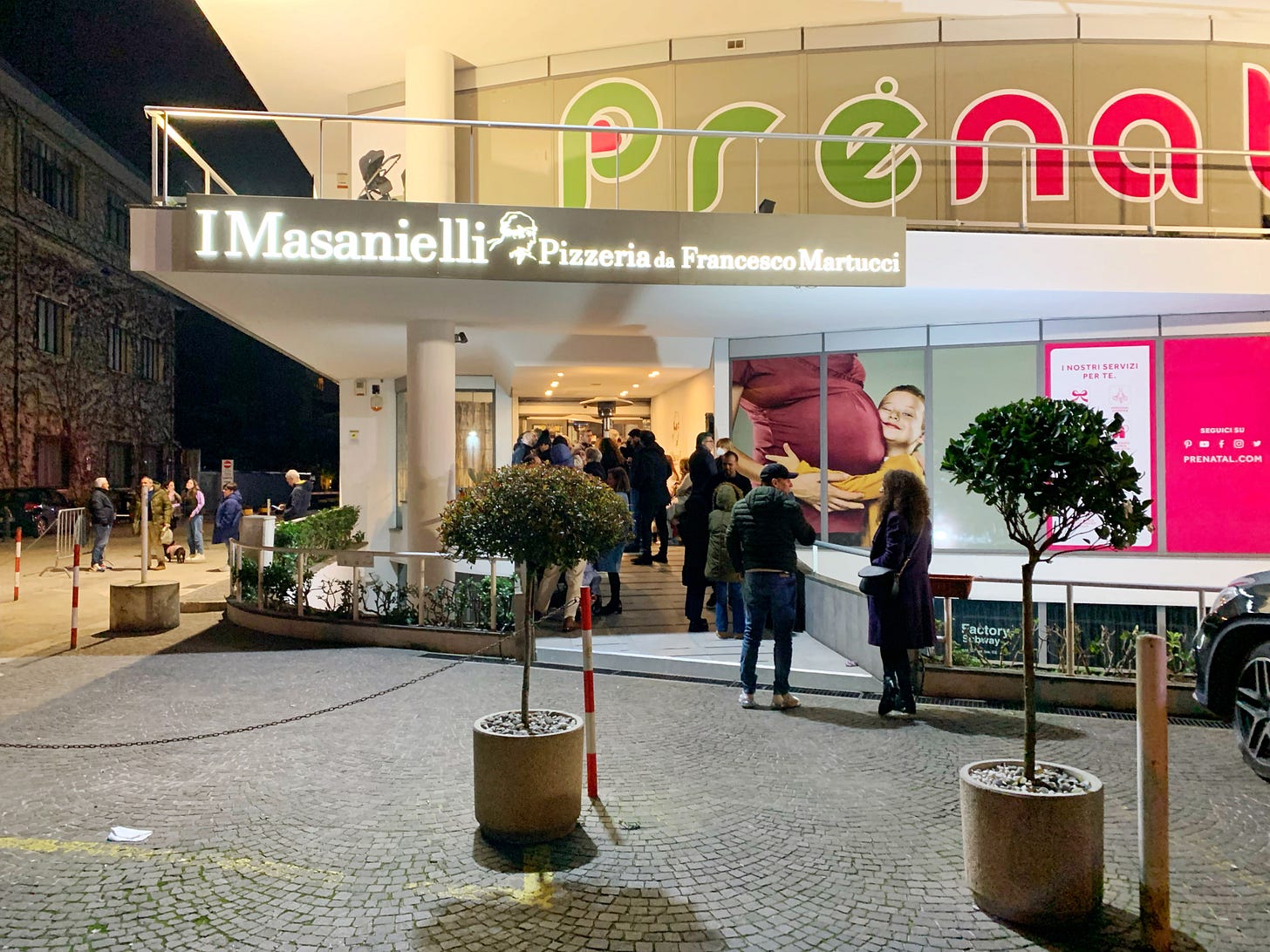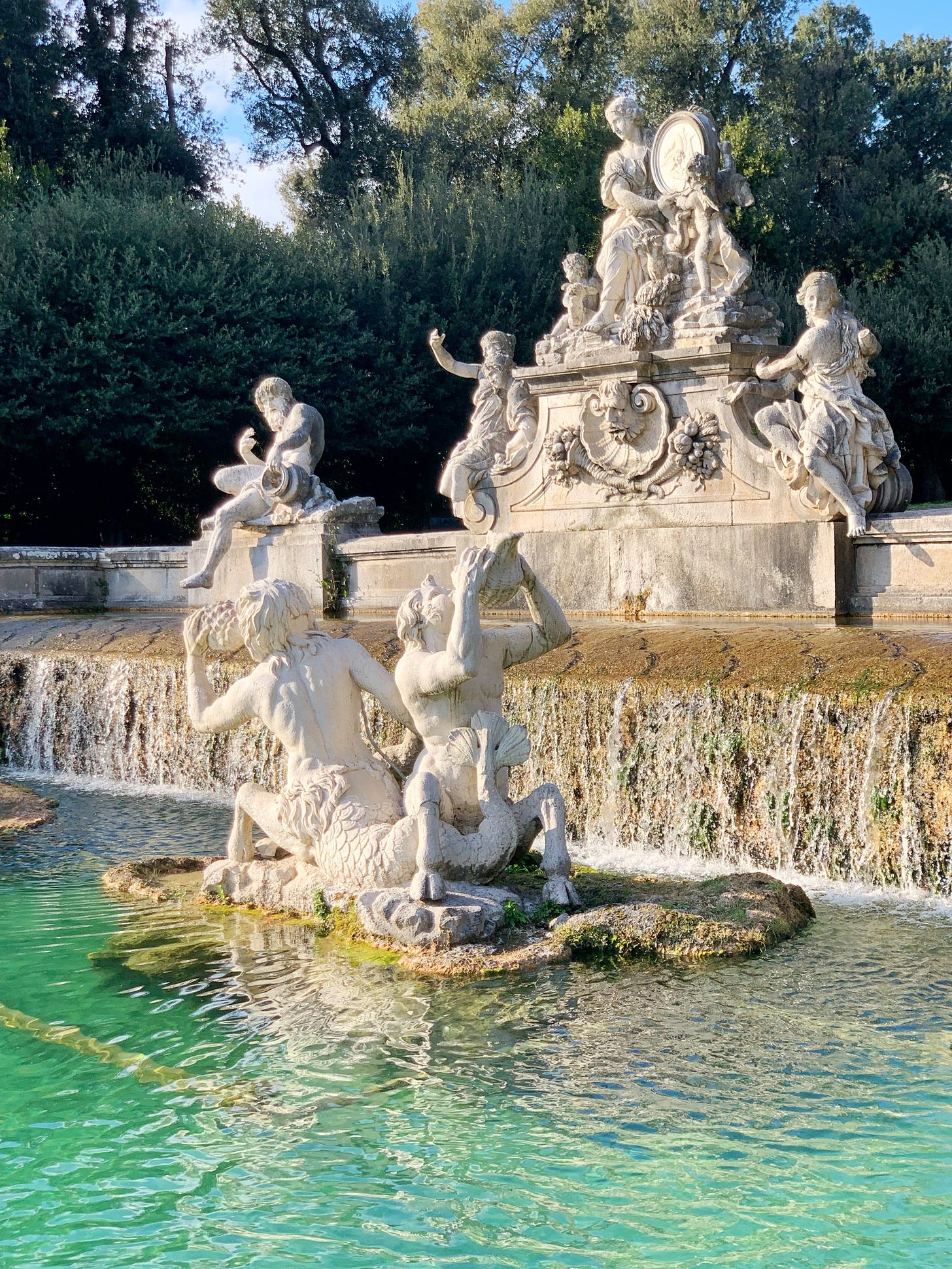Do you know where to find Italy’s—and by extension—the world’s best pizza? If you said Naples, you’re not far off. The birthplace of pizza may be Naples, but if you want to taste the best pizza in Italy, you’ll have to travel about 40 minutes north of the city to Caserta. Seven of the pizzerias ranked on the list of the Top 50 in Italy are located in Caserta and the surrounding towns.
Though Caserta is still under-the-radar, it’s becoming a pilgrimage site for serious pizza lovers, and my husband Marco and I proudly count ourselves among them. It’s also home to the Reggia di Caserta, a royal palace that rivals Versailles in size and splendor.
Marco and I have been to Caserta twice so far this year, and for this week’s issue, I’m lifting the curtain to tell you the story behind my stories about it for Food & Wine and Travel + Leisure.
It all started at the end of last year. Coincidentally, around the same time that the New York Times published a feature about a pizza pilgrimage to Campania, Marco asked me if I could make a reservation at I Masanielli, ranked the #1 pizzeria in the world by Top 50 Pizza. (It topped this year’s recently released list again.) I immediately logged onto I Masanielli’s online reservation system and booked a table two months in advance.
“How can a pizzeria be so special that you need to book a table two months in advance?” you might be wondering. “Can’t you get great pizza all over Italy?”
Francesco Martucci, I Masanielli’s pizzaiolo/proprietor, is one of a wave of next gen pizzaioli raising the profile of this traditionally humble food to stratospheric heights. He draws his inspiration not from other pizzerias, but from Michelin-starred restaurants. First and foremost is a commitment to using the best quality ingredients, like fresh mozzarella di bufala, capers from Salina, anchovies from Trapani, and San Marzano tomatoes. But he goes a step further by employing the kind of high-tech equipment you would normally only find in gourmet restaurants—dehydrators, sous vide machines, flash freezers, and the like—to draw out the flavors and textures of the toppings.
After wading our way through the crowd outside the doors of I Masanielli and being seated at our table, Marco and I started with a trio of fritti, the fried starters usually served as appetizers at Italian pizzerias. Then he had the 5 Consistenze della Cipolla, a wood-fired pizza with fior di latte mozzarella and onions in five ways (onion cream, fermented onion, crispy onion, burnt onion, and onion mayonnaise) and I had the Genovese Secondo Martucci, inspired by the Neapolitan genovese pasta sauce. Both pizzas were sublime—a symphony of flavors and textures that left us wanting more.
Before the trip, I had watched the episode of Chef’s Table: Pizza dedicated to Franco Pepe, the master pizzaiolo of Pepe in Grani in Caiazzo, about 20 minutes from Caserta. Some credit Pepe with ushering in the movement to elevate pizza to a gourmet food, paving the way for others like Martucci. So when we got home after our trip to I Masanielli, the first thing I did was make a reservation at Pepe in Grani. That’s why, just six weeks after going to Caserta for the first time, we returned, this time with a couple of friends in tow.
This time around, we did the pizza tasting menu, which ended up igniting a debate at our table about the price (€35 - 65 for a six- to twelve-course tasting menu), which I wrote about for Food & Wine. I won’t bore you with the details because frankly, if you’re coming from an expensive city like New York, the price will likely seem like a bargain.
More importantly, I want to address the question: Is a detour to Caserta worth your time?
I’m not going to lie to you—Caserta doesn’t fit the postcard-perfect image of Italy that many people seek when they come here. The city was bombarded during the Second World War and much of the area around the Reggia was rebuilt in the post-war era seemingly without much consideration for aesthetics. (The Reggia actually served as the Allied Force Headquarters and when the German forces surrendered in April 1945, they did it there.) I Masanielli is located in a commercial building adjoining a store for baby clothes on a long, wide boulevard. The area is definitely not Instagram fodder.
The Reggia di Caserta, while quite impressive, is also a bit rough around the edges. Fodor’s review of the Reggia declares, “Though the palace is not as well maintained as its French counterpart, the main staircase puts the one at Versailles to shame, and the royal apartments are sumptuous.”
Walking through the royal apartments, it wasn’t hard to see the comparison with Versailles. The throne room is over 130 feet long, with ornate gilded moldings and decorations on the walls. The throne, which would have been on a raised base, is made of carved and gilded wood with light blue velvet upholstery. The grounds are massive, with impressive fountains.
But the best part, in my opinion, is that it wasn’t crowded at all. We went to the Reggia on both of our trips to Caserta and both times, there were other visitors, but on the whole it felt like we almost had the place to ourselves. That in and of itself is a luxury, especially as overtourism runs rampant in other parts of Italy.
So is it worth it? I think it depends on your priorities and whether it fits into your itinerary, geographically speaking. It’s definitely not for the kind of person who expects a perfectly manicured version of Italy and I wouldn’t advise you to go all the way there if it would require going far out of your way. But if you’re planning a trip to, say, Rome, Naples, or the Amalfi Coast, are ready to get off the beaten path, and want to taste some truly extraordinary pizza and visit a magnificent royal palace in an under-the-radar destination, then you should absolutely plan a detour to Caserta. Just make sure you book your table at I Masanielli or Pepe in Grani far in advance.
Further Reading
After our first trip to Caserta, I wrote about what it’s like to eat at the world’s best pizzeria for Food & Wine.
And here’s the aforementioned article for Food & Wine in which I ask, Is pizza getting too gourmet for its own good?
My latest article for Travel + Leisure has more details about the Reggia di Caserta and why this under-the-radar city should be on your radar.
Here’s the New York Times article I referenced about a pizza pilgrimage to Campania (unlocked).
You can see the full 2023 list of the Top 50 pizzerias in Italy here.












As a House of Bourbon enthusiast, I needed no convincing, but nonetheless I enjoyed the article. I intend to make a beeline to Caserta from the Naples train station!
Thanks for the tip! I had never actuallyy heard of Caserta, but reading this made me want to go. Next time I'm in the area, I will definitely go there, both for the food and for the architecture.